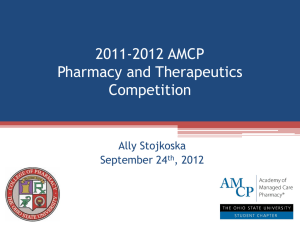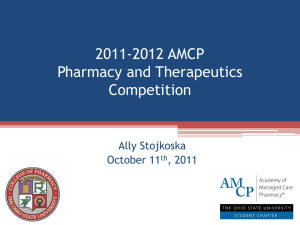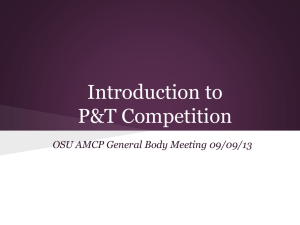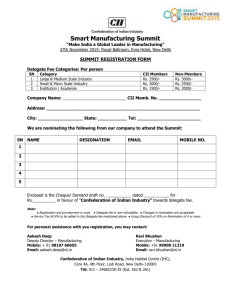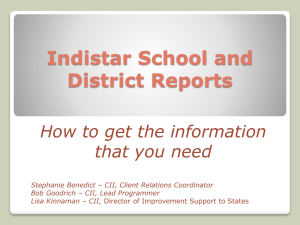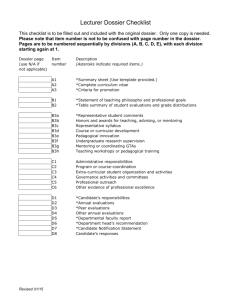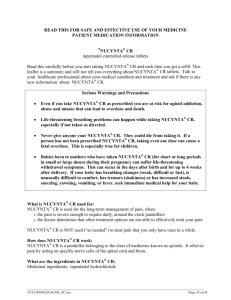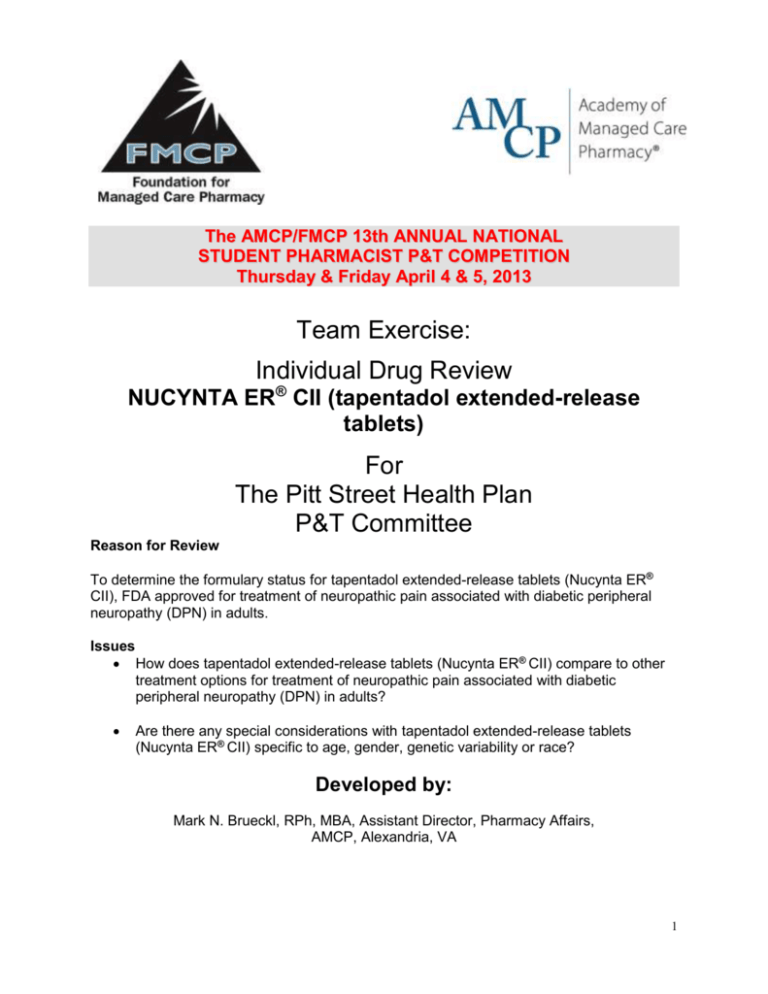
The AMCP/FMCP 13th ANNUAL NATIONAL
STUDENT PHARMACIST P&T COMPETITION
Thursday & Friday April 4 & 5, 2013
Team Exercise:
Individual Drug Review
NUCYNTA ER® CII (tapentadol extended-release
tablets)
For
The Pitt Street Health Plan
P&T Committee
Reason for Review
To determine the formulary status for tapentadol extended-release tablets (Nucynta ER®
CII), FDA approved for treatment of neuropathic pain associated with diabetic peripheral
neuropathy (DPN) in adults.
Issues
How does tapentadol extended-release tablets (Nucynta ER® CII) compare to other
treatment options for treatment of neuropathic pain associated with diabetic
peripheral neuropathy (DPN) in adults?
Are there any special considerations with tapentadol extended-release tablets
(Nucynta ER® CII) specific to age, gender, genetic variability or race?
Developed by:
Mark N. Brueckl, RPh, MBA, Assistant Director, Pharmacy Affairs,
AMCP, Alexandria, VA
1
The Foundation for Managed Care Pharmacy and Janssen Pharmaceuticals, Inc. grant
permission for the use of this material only by members of AMCP Student Chapters
participating in the 2013 AMCP/FMCP Student Pharmacist P&T Committee Competition.
No part of these documents may be reproduced, stored in a retrieval system, or
transmitted in any form or by any means—electronic, photocopying, or otherwise—
without the permission of the authors.
While this team exercise involves the use of an actual product dossier and model, the
exercise is not meant to illustrate either effective or ineffective handling of the formulary
management issues within a managed care organization.
ACKNOWLEDGEMENTS
The Foundation for Managed Care Pharmacy is grateful to Janssen Pharmaceuticals, Inc.
for the use of its dossier for tapentadol extended-release tablets (Nucynta ER® CII) for
this competition.
The Foundation greatly appreciates the generous support of Genentech, Amgen and
Dymaxium for making this singular event possible.
2
Guidelines & Instructions
SEE THE ACCOMPANYING DOCUMENT for CRITICAL DATES & DEADLINES
From case study analysis and presentation materials submitted by the winning teams from each
participating AMCP Student Chapter, the National P&T Committee Competition Selection
Committee will select the eight (8) finalist teams to participate in the 13th Annual National P&T
Competition at the AMCP 25th Annual Meeting & Expo in San Diego, CA, April 4-5, 2013.
Team Composition:
Each competing team must consist of 4 members.
Although not required, the ideal team will be composed of one pharmacy student from
each of the four (4) professional academic years (residents, fellows and other postgraduate students are not eligible).
Participating Chapter and team member identity will be blinded to the semi-finalist
judges. Each participating Chapter will be assigned an identifying number that must be
included on each page of their competition documents
There is no limit to the number of four-member teams a student chapter may field for
their individual chapter (local) competition although individual Chapters may set limits.
Each team will choose a team captain who will be responsible for ensuring that their
team meets all requirements and deadlines as detailed these guidelines, the attached
documents, and in the case study to follow.
The student chapter president or designated P&T Competition Coordinator and the
faculty advisor will be responsible for relaying all communications with FMCP to all team
members.
o Individual team members may not contact FMCP staff directly. Team members
must direct their questions to their Chapter President, Competition Coordinator,
or Faculty Advisor who will relay questions to FMCP and relay answers to ALL
team members. See Item 12, Submission Formatting, for details.
Chapter winning team submissions will be blinded. Each Chapter will be assigned an
identifying number that must appear in the header of each page of their submitted
documents.
Each team member must be an AMCP Student Member
Each member of the eight teams selected to compete in the Competition finals
must register for the AMCP 25th Annual Meeting & Expo in San Diego, CA, April 45, 2013.
Competition Judges - Each competing school chapter will convene a local P&T Competition
Judging Panel that will be comprised of two to three faculty members or other health care
professionals chosen by the Student Chapter. FMCP will choose the judges for the National
Competition.
Deadlines – A complete timeline may be found on the P&T Competition website:
www.amcp.org/fmcpPT (note: you must log in with your AMCP membership number to access P&T
Competition resources). Failure to meet the prescribed deadlines may result in team
disqualification.
3
Awards:
Each of the eight AMCP Student Chapter teams selected as finalists to compete in the
National P&T Competition in San Diego will receive a $4,000.00 team stipend to be used to
help defray travel and other competition related expenses.
This stipend, payable to the Student Chapter, will be sent out to the AMCP Student
Chapter Faculty Advisor upon confirmation of participation of the selected team in
the final competition.
Each sponsoring Student Chapter is responsible for the allocation of these funds and
is to be used solely to help defray team member travel expenses.
Finalists teams are responsible for making their own travel and hotel arrangements for the
Annual Meeting. FMCP and the Competition sponsor will announce the first, second and
third place winners on Friday, April 5, 2013 during the Student and New Member Reception
at the AMCP 25th Annual Meeting & Expo. Award plaques will be presented at that time.
FMCP will provide a travel stipend for the first place team and faculty advisor to attend the
2013 AMCP Educational Conference in San Antonio, Texas on October 16-18, 2013. The
P&T Competition sponsor will formally award the team members their engraved plaque
during one of the Conference General Sessions.
Each of the three winning teams will receive a contribution to their school’s general
scholarship fund in the following amounts: To the first place team’s school - $2,500.00; 2nd
place - $1,500.00; 3rd place - $1,000.00.
Presentation Requirements:
The team exercise involves analysis of the tapentadol dossier, which is based on the AMCP
Format for Formulary Submissions, Version 3.0 (available at www.amcp.org or
www.fmcpnet.org) NOTE: All competing team members and judges are required to have a
working knowledge of these guidelines!
1.
o In addition, the team exercise will require that each team to engage in
considerable independent research. It is estimated that each team will require
40 hours to complete their research and the required competition documents.
o Each four-member team must prepare a report that answers specific questions
and provides an analysis of the merits of an AMCP Format-based product
dossier.
o Teams will also prepare a P&T Committee monograph (20-page maximum) and
a PowerPoint presentation (30-slide, 30-minute maximum), and present this
information before the P&T Competition Judging Panel at their respective school
or college of pharmacy.
o Due to time constraints, teams may not present more than 30 PowerPoint slides.
o In addition to team PowerPoint slides, each team may provide handouts (five (5)
pages maximum) for the judges to aid in their presentation.
2. Coaching: Faculty and/or Student Chapters MAY NOT conduct coaching sessions that
explicitly influence team document content and decisions. However, faculty may provide
basic information on managed care pharmacy practice, P&T committee functions,
pharmacoeconomics and pharmacoeconomic models, and pharmacy benefit design. In
addition, faculty and staff may be consulted to verify or clarify information gathered
through independent research.
3. If the case study involves a very complex disease state, faculty advisors may engage a
specialist in the particular field to educate ALL team members on the natural course of
the disease. All such education must be done on an equal basis for all team members.
4
o
4.
5.
6.
7.
However, the experts are to refrain from any editorial comment (expert opinion)
on the merits or lack of merit of the treatment options for these diseases so as to
not unduly influence the students’ decisions.
General assistance with presentation and writing skills is also permissible.
Teams may NOT confer with members of competing teams; however, team members
may review previous team materials with previous team members, provided that all
teams have equal access.
Chapters participating for the first time may seek general advice about the competition
from members at chapters that have participated in the past.
Research: All resources must be referenced in all submitted materials. The
Nucynta ER® CII dossier is just one evidence source. As in real life, team members are
expected to access all available evidence sources to confirm the validity of the evidence
presented in the dossier, to validate the manufacturer’s value argument, and support
their recommendation for formulary status. Judges may challenge the team on the
source and validity of any claims made in the summary or presentation. Be aware of
bias and reference credibility.
8. Judging: Written materials and oral presentations will be judged on a number of factors
including, but not limited to:
o Demonstrating an in-depth knowledge and understanding of the AMCP Format
for Formulary Submissions Version 3.0 (available at www.fmcpnet.org,
Resources Section).
o Demonstrating an in-depth knowledge and understanding of the product under
consideration, alternative therapies, and the related disease state(s).
Ability to answer detailed questions about the above.
o Demonstrating that teams have conducted independent research to verify the
validity of the data contained in the dossier and to support their arguments for or
against addition of this product to the formulary.
o Answers must be defended, logical, clear and rational and in sufficient detail.
Teams will receive point deductions if page limits and other formatting
requirements are not followed.
o All reports and presentations must be well referenced
o Reports and presentations must be neat, grammatically correct and exhibit
continuity and team collaboration.
o NOTE: Competing teams are scored on a weighted scale with the majority of
points (up to 70%) given to written materials.
Teams will be penalized for exceeding page limits.
Models: In the absence of an economic model provided by the manufacturer, a few
teams in previous competitions have developed their own models to better inform their
coverage decision. This is permissible but will not earn additional points. Note: The
manufacturer has not provided an economic model for Nucynta ER® CII. Models may
not exceed five (5) pages.
9. Presentation Time Limits - Local and National Competition: Each P&T Competition
team will have a total of 60 minutes – 5 minutes to set-up; 30 minutes to present; 20
minutes for P&T Committee Competition Judging Panel questions, and 5 minutes to
breakdown.
10. Following local competition completion, the winning team may not make any
changes to their presentation materials prior to the national competition unless
5
new evidence has become available that causes the team to change/modify their
recommendation to the P&T Committee. In this case, both the original and
revised recommendation must be documented and justified.
11. The National AMCP P&T Committee Competition Selection Committee will use the
material submitted to make their selection for finalist teams.
12. Submission Formatting
o Written Report Format: All written documents must conform to these
requirements. Teams will lose points for not following these
requirements.
Microsoft Word only…no PDF files
1.5 line spacing, (except Monograph – see below)
Times New Roman, 12-point font,
One (1) inch margins – top, bottom, left and right,
Pages must be numbered with Chapter identification number
as a header on each page (12-point font only)
Chapter names and team member names may NOT appear on
any documents
Submit answers to questions A - D (below) as one document
Include question at top of first page of corresponding
answer.
One cover page is permissible but must not contain graphics
or any AMCP Chapter or team member identifying information
except for the indentifying number.
o Monograph Exceptions: Times New Roman text, 12-point, 1-inch
margins, single line spacing.
Evidence table pages are to be in landscape format, may have
0.5-inch margins, and text in evidence tables may be no less
than 8-point)
13. PowerPoint Presentation Format
All teams must use the attached PowerPoint template – no
exceptions.
All slides must be readily printable in either grayscale or black
and white with no manipulation of colors or fonts required due
to loss of content in the conversion from color to B&W,
especially charts, graphs and tables.
See the attached PowerPoint Presentation Rubric (Page 12) for
other presentation formatting recommendations. This rubric
may also be used by judges as a guide to grading team slide
sets.
Visit the P&T Competition website (www.amcp.org/fmcpPT)
for CRITICAL DATES & DEADLINES
6
Questions? Contact:
Mark Brueckl
(703) 683-8416 ext. 609
mbrueckl@amcp.org
The Competition is Made Possible through the Generous Support of
7
Pitt Street Health Plan – Team Exercise
Pitt Street Health Plan – a snapshot
Pitt Street Health Plan, a 3.4 million-member health plan in your state, pays for more than $630
million of ambulatory (“retail”) prescription drugs each year. Their Rx costs per member per
month (PMPM) went up 18% in 2010 with no noticeable decrease in hospital or other medical
costs. As a result the Pharmacy Vice President of Pitt Street Health, supported by the CEO,
has decided that a new evidence-based approach must be made for formulary decisions –
looking at health outcomes (clinical, quality of life, medical costs) as well as actual drug average
wholesale price (AWP) costs and volume purchase discounts (rebates). The Pharmacy VP and
the three Clinical Pharmacists decided to request product dossiers based on version 3.0 of the
AMCP Format for Formulary Submissions.
Pitt Street Health has its own P&T committee. In January they appointed a leading
pharmacoeconomist from the local College of Pharmacy to chair the committee. Other
members include the pharmacy director, four family practice physicians, a cardiologist and a
nurse practitioner.
Pitt Street Health clinical pharmacy staff makes reports and oral
presentations to the P&T committee, but have no vote. Other specialists such as neurologists,
immunologists, and endocrinologists are consulted as necessary.
The P&T committee meets quarterly. Under the new guidelines adopted by Pitt Street Health
and the P&T committee, no drug will be reviewed without a manufacturer-submitted dossier. (If
in the rare event a drug is truly a “breakthrough”, the Pitt Street Health Plan pharmacy directors
can develop interim guidelines for prior authorization.)
The demographics of Pitt Street Health include:
3,400,000 covered lives; Gender distribution is 51.4% female, 48.6% male
Age distribution is:
Younger than 18:
18-65 years:
Over 65:
28.5%
61%
10.5%
Available Therapeutic Alternatives:
Prescription Benefit
Preferred/Formulary
Amitriptyline (generic)
Gabapentin (generic)
Carbamazepine (generic)
Tramadol (generic) [moderate to severe pain
indication]
Acetaminophen/Codeine (generic) [moderate
to severe pain indication]
Acetaminophen/Hydrocodone (generic)
[moderate to severe pain indication]
Standards of Care
Diabetic Peripheral Neuropathy
Exclude non-diabetic causes
Assess level of blood glucose control
Non-Preferred/Non-Formulary
Pregabalin (Lyrica®)
Lamotrigine (Lamictal®)
Oxycodone CR (Oxycontin®) [moderate to
severe pain indication]
tapentadol extended-release tablets
(Nucynta ER® CII)
Aim for optimal, stable control
Your Team Assignment
Your student team represents the four clinical pharmacists for Pitt Street Health. Normally just
one clinical pharmacist would review a new drug’s dossier; in this case, however, you are
working together.
Each four-member team of “Clinical Pharmacists” for Pitt Street Health will:
.
1. Become intimately familiar with the AMCP Format for Formulary Submissions Version
3.0 (available at www.fmcpnet.org or www.amcp.org). Faculty advisors and judges are
to do the same.
2. Carefully research, review and discuss the tapentadol extended-release tablets
(Nucynta ER® CII) (Nucynta ER® CII) dossier and all other available evidence. Faculty
advisors and judges are to do the same.
P&T Committee Background: At its next meeting, the Pitt Street Health P&T Committee will
conduct a review of the place in therapy of the opioid agonist tapentadol extended-release
tablets (Nucynta ER® CII). Specifically, the Committee will determine the formulary status of
tapentadol extended-release tablets (Nucynta ER® CII), FDA approved for treatment of
neuropathic pain associated with diabetic peripheral neuropathy (DPN) in adults .
1. Currently the status of tapentadol extended-release tablets (Nucynta ER® CII) is nonpreferred. Following your review of the dossier and your own independent research of
other available evidence, the issue you must address is whether there is sufficient
evidence to support the value of tapentadol extended-release tablets (Nucynta ER®
CII) for a change in status to Preferred/Formulary. In other words, through analysis of
the dossier and your additional research, should tapentadol extended-release tablets
(Nucynta ER® CII) be added to the formulary or not and, if added, what should be the
coverage criteria? Remember, the dossier represents only one source of information on
the value of tapentadol extended-release tablets (Nucynta ER® CII) to the Pitt Street
Health Plan patient population.
TEAM ASSIGNMENT (items A to F)
Each team will answer the following four questions:
A. Prepare a report that evaluates the overall quality of the dossier. That is, how well did
the manufacturers follow the AMCP Format for Formulary Submissions Version 3.0 and
the WellPoint Guidelines? Briefly discuss what was done well, what content was
missing, and where the instructions were not followed. (4-page maximum, 1.5 line
spacing, Times New Roman, 12-point font)
B. Analyze the manufacturers’ value proposition for tapentadol extended-release tablets
(Nucynta ER® CII). Does the clinical and economic data presented in the dossier
support the manufacturer’s value arguments? Has the manufacturer excluded any
information that would refute their value argument for the labeled indication? Include an
analysis of the modeling section, key studies not included and any potentially misleading
information contained in the dossier.
9
a. Using the Delfini Validity & Usability Grading Scale for Summarizing the
Evidence for Interventions (Page 11) grade the strength of studies summarized in
the dossier. Determine for each study whether it appears both valid and useful
to support health care decisions. Using bullets list any notable flaws or
inconsistencies in each study. Refer to the document Evidence Grading,
Wording Conclusions and Results Tables by the Delfini Group for additional
information.
(Go to http://www.delfini.org/Delfini_Tool_GradingConclusionsResults.doc)
(5-page maximum – same formatting as “A” - references only may extend
to a 6th page).
C. Describe how the product formulation, abuse potential, and federal and state regulations
to control abuse, such as states’ prescription drug monitoring programs, might influence
a formulary decision.
(3-page maximum - same formatting as “A” - references only may extend to a 4th
page).
D. Describe how a patient’s quality of life may be impacted by taking tapentadol extendedrelease tablets (Nucynta ER® CII) versus oxycodone CR, pregabalin or other preferred
and non-preferred products in terms of diet, weight gain, drug-drug interactions, fooddrug interactions, etc. How much influence would this have in a formulary decision?
(3-page maximum - same formatting as “A” - references only may extend to a 4th
page).
E. Prepare a P&T Committee Monograph:
a. The P&T committee is made up of a pharmacoeconomist (chair), a pharmacist
and four family practice physicians, one cardiologist, a nurse practitioner, a
consultant neurologist and consultant pain management specialist. They are all
very busy. It is the clinical pharmacy staff’s responsibility to reduce the massive
dossier and other accumulated evidence to manageable information for the P&T
members.
b. Therefore, in addition to answering the above questions, your team is to prepare
an individual drug review monograph that summarizes the evidence for the
safety, efficacy, effectiveness and cost-effectiveness of tapentadol extendedrelease tablets (Nucynta ER® CII) and any useful evidence comparing it to
other treatment options for the labeled indications. The monograph will
include your recommendations to the P&T Committee on the place in therapy of
and whether there is sufficient evidence to support the value of tapentadol
extended-release tablets (Nucynta ER® CII) for a change in status to
Preferred/Formulary. In other words, should the drug be added to the formulary
or not and, if added, what will be the coverage criteria?
Use the attached
template (P&T Committee Monograph Template).
(20-page limit, see
formatting exceptions on page 12 - references may extend to page 21).
i. NOTE: Evidence presented to support your recommendations must
be graded.
ii. You must use the attached Monograph Template.
F. Prepare a 30 minute oral and PowerPoint presentation that you will utilize for the actual
competition. (Limit: 30 slides)
c. NOTE: You should assume that the P&T committee members have sufficient
knowledge of the physiology and etiology of the relevant disease states/drug
indications. Therefore your PowerPoint slides and oral presentation should focus
10
primarily on the evidence for value and supporting your recommendations for
formulary status.
In summary, each competing team will complete the following requirements:
A. Study the dossier and conduct independent research on the etiology, diagnosis,
treatment and prevention of neuropathic pain associated with diabetic peripheral
neuropathy.
B. Study the AMCP Format for Formulary Submissions Versions 3.0 and the WellPoint
Guidelines
C. Address the issue of whether there is sufficient evidence to support the value of
tapentadol extended-release tablets (Nucynta ER® CII) for addition to the formulary
and answer questions 5a-d.
D. Prepare a P&T Committee individual drug review monograph for tapentadol
extended-release tablets (Nucynta ER® CII) (maximum of 20 pages plus references)
that details the important information for the P & T Committee members to
consider and your recommendations for P&T Committee action. (Follow the
attached P & T Monograph Template).
E. Prepare a 30-minute oral presentation with Power Point slides that you will utilize
for the actual competition. (maximum of 30 slides)
Tips - Evaluating the Evidence
1.
Deal with evidence gaps
a. Do studies answer the questions you are asking?
b. Are only intermediate outcomes reported?
c. Are results statistically significant?
d. Are results clinically significant?
e. Have populations of interest been excluded?
f. Does the data support the authors’ conclusion?
Grade the evidence (e.g. McMaster or other Grading System – see page 13 for
examples)
Look for bias (observational and selection)
Follow the checklist for good models:
2.
3.
4.
Checklist for Good Models
Structure
Is it a disease-progression model with appropriate time horizon?
Are the treatment pathways relevant to the decision?
Does it model usual clinical practice?
Are the mathematics of the model accurate and available for inspection?
Data
Are the sources of evidence valid?
Have the data been interpreted and incorporated accurately?
Have uncertainties in the data been addressed?
Are linkages between intermediate and long-term outcomes:
Valid?
Based on appropriate (trial or retrospective) evidence?
Presentation
Are outcomes relevant to decision-making in the health plan?
11
Was incremental analyses performed on both health effects and costs?
Are outcomes verifiable, i.e. traceable back to the inputs and model structure?
Is uncertainty in the data tested in a reasonable fashion?
Is the sensitivity analysis displayed via tornado diagram?
Are results and uncertainty presented in a fashion that facilitates incorporation into
formulary monographs and decision-making?
12
Delfini Validity & Usability Grading Scale for Summarizing the Evidence for Interventions
Strength of Evidence Advice
Grade of
Usability
Grades can be applied to individual studies, to conclusions within studies, a body of
evidence or to secondary sources such as guidelines or clinical recommendations.
General advice is provided below.
●
The evidence is strong and appears sufficient to use in making health care decisions – it is both valid and
useful (e.g., meets standards for clinical significance, sufficient magnitude of effect size, physician and patient
acceptability, etc.)
Grade A:
Useful
Advice: Studies achieving this grade should be outstanding in design, execution and reporting with useful
information to aid clinical decision-making, enabling reasonable certitude in drawing conclusions.
For a body of evidence:
Several well-designed and conducted studies that consistently show similar results
Grade B:
Possibly Useful
For therapy, screening, prevention and diagnostic studies: RCTs. In some cases a single, large welldesigned and conducted RCT may be sufficient; however, without confirmation from other studies results
could be due to chance, undetected significant biases, fraud, etc. In such instance the study might
receive a Grade A, but the Strength of the Evidence should include a cautionary note.
For natural history and prognosis: Cohort studies
The evidence appears potentially strong and is probably sufficient to use in making health care decisions some threats to validity were identified
Advice: Studies achieving this grade should be of high quality in design, execution and reporting with nonlethal threats to validity and with sufficiently useful information to aid clinical decision-making, enabling
reasonable certitude in drawing conclusions.
For a body of evidence:
The evidence is strong enough to conclude that the results are probably valid and useful (see
above); however, study results from multiple studies are inconsistent or the studies may have some (but not
lethal) threats to validity.
For therapy, screening, prevention and diagnostic studies: RCTs. In some cases a single, large welldesigned and conducted RCT may be sufficient; however, without confirmation from other studies results
could be due to chance, undetected significant biases, fraud, etc. In such instance the study might
receive a Grade A, but the Strength of the Evidence should include a cautionary note.
Also for diagnosis, valid studies assessing test accuracy for detecting a condition when there is evidence
of effectiveness from valid, applicable RCTs.
For natural history and prognosis: Cohort studies
Grade B-U:
Possible to
uncertain
usefulness
The evidence might be sufficient to use in making health care decisions; however, there remains sufficient
uncertainty that the evidence cannot fully reach a Grade B and the uncertainty is not great enough to fully
warrant a Grade U.
○
There is sufficient uncertainty that caution is urged regarding its use in making health care decisions.
Study quality is such that it appears likely that the evidence is sufficient to use in making health care
decisions; however, there are some study issues that raise continued uncertainty. Health care decisionmakers should be fully informed of the evidence quality.
Grade U:
Uncertain
Validity and/or
Usefulness
Uncertain Validity: This may be due to uncertain validity due to methodology (enough threats to validity
to raise concern – our suggestion would be to not use such a study in most circumstances) or may be
due to conflicting results.
Uncertain Usefulness: Or this may be due to uncertain applicability due to results (good methodology, but
questions due to effect size, applicability of results when relating to biologic markers, or other issues).
These latter studies may be useful and should be viewed in the context of the weight of the evidence.
Uncertain Validity and Usefulness: This is a combination of the above.
Uncertainty of Author: If the author has reached a conclusion that the findings are uncertain, doing a
critical appraisal is unlikely to result in a different conclusion. The evidence leaves us uncertain
regardless of whether the study is valid or not. Critical appraisal is at the discretion of the reviewer.
Reproduced with permission
© Delfini Group, LLC, 2005-2008. All Rights Reserved World Wide.
13
PowerPoint Presentation Rubric
CATEGORY
Background
Commendable
4.5 to 6 points
Background does not
detract from text or other
graphics. Choice of
background is consistent
from card to card and is
appropriate for the topic.
Satisfactory
3 to 4.5 points
Background does not
detract from text or
other graphics.
Choice of
background is
consistent from card
to card.
Font formats have
been carefully
planned to enhance
readability.
Developing
1.5 to 3 points
Background does not
detract from text or
other graphics.
Needs Attention
0 to 1.5 points
Background makes it
difficult to see text or
competes with other
graphics on the page.
Font formatting has
been carefully
planned to
complement the
content. It may be a
little hard to read.
Font formatting makes it
very difficult to read the
material.
Text - Font Choice
& Formatting
Font formats (e.g.,
colour, bold, italic) have
been carefully planned to
enhance readability and
content.
Use of Graphics
All graphics are attractive
(size and colours) and
support the
theme/content of the
presentation.
A few graphics are
not attractive but all
support the
theme/content of the
presentation.
All graphics are
attractive but a few
do not seem to
support the
theme/content of the
presentation.
Several graphics are
unattractive AND
detract from the content
of the presentation.
Sequencing of
Information
Information is organized
in a clear, logical way. It
is easy to anticipate the
type of material that
might be on the next
card.
Most information is
organized in a clear,
logical way. One card
or item of information
seems out of place.
Some information is
logically sequenced.
An occasional card or
item of information
seems out of place.
There is no clear plan
for the organization of
information.
Content - Accuracy
All content throughout
the presentation is
accurate. There are no
factual errors.
Most of the content is
accurate but there is
one piece of
information that might
be inaccurate.
The content is
generally accurate,
but one piece of
information is clearly
flawed or inaccurate.
Content is typically
confusing or contains
more than one factual
error.
Originality
Presentation shows
considerable originality
and inventiveness. The
content and ideas are
presented in a unique
and interesting way.
Presentation shows
some originality and
inventiveness. The
content and ideas are
presented in an
interesting way.
Presentation shows
an attempt at
originality and
inventiveness on 1-2
cards.
Presentation is a rehash
of other people's ideas
and/or graphics and
shows very little attempt
at original thought.
Presentation has no
misspellings or
grammatical errors.
Presentation has 1-2
misspellings, but no
grammatical errors.
Presentation has 1-2
grammatical errors
but no misspellings.
Presentation has more
than 2 grammatical
and/or spelling errors.
Spelling and
Grammar
14
Pitt Street Health Plan Formulary Monograph Template
Individual Drug Review
Generic Name:
tapentadol extended-release tablets CII
Brand Name:
Nucynta ER CII
Manufacturer:
Janssen Pharmaceuticals, Inc.
®
Date of Review:
Available Therapeutic Alternatives:
Prescription Benefit
Preferred/Formulary
Amitriptyline (generic)
Gabapentin (generic)
Carbamazepine (generic)
Tramadol (generic) [moderate to severe pain
indication]
Acetaminophen/Codeine (generic) [moderate
to severe pain indication]
Acetaminophen/Hydrocodone (generic)
[moderate to severe pain indication]
Non-Preferred/Non-Formulary
Pregabalin (Lyrica®)
Lamotrigine (Lamictal®)
Oxycodone CR (Oxycontin®) [moderate to
severe pain indication]
tapentadol extended-release tablets
(Nucynta ER® CII)
TABLE OF CONTENTS:
(Click on a link below to view the section.)
Executive Summary
Recommendations
Key Questions/Issues:
Issue 1: Efficacy
Issue 2: Comparative Effectiveness
Issue 3: Safety
Issue 4: Value Proposition
Issue 5: Cost-effective Patient Subgroups
Clinical Evidence Tables
Cost-effectiveness Evidence Tables
Background
Disease Background
Pharmacotherapy
Product Background
Methodology
Authorship
References
15
Abbreviations used in this monograph:
16
REASON FOR REVIEW:
To determine the formulary status for tapentadol extended-release tablets (Nucynta ER® CII), FDA
approved for treatment of neuropathic pain associated with diabetic peripheral neuropathy (DPN) in
adults.
EXECUTIVE SUMMARY
Key Questions/Issues and Results of Investigation:
Issue 1: What is the evidence of efficacy from clinical trials?
[Text. The answers to key questions in the Executive Summary should normally be no more than a
paragraph of modest length. If no evidence was found to answer a particular question, state “No evidence
found.”]
Issue 2: Is there sufficient evidence to assess real world comparative effectiveness?
[Text]
Issue 3: What is the evidence of safety?
[Text].
Issue 4: What is the value proposition for this product?
[Text].
Issue 5: Are there identifiable patient subgroups in which this treatment will be most cost-effective?
[Text].
RECOMMENDATIONS TO THE COMMITTEE
[Summary of findings, key issues & conclusions, 1 or 2 short paragraphs that explain the logic
leading to your recommendations.]
Therefore, the following P&T action is recommended:
17
ISSUE DETAILS
ISSUE 1: What is the level and quality of evidence for efficacy from clinical trials?
Treatment of neuropathic pain associated with diabetic peripheral neuropathy (DPN) in
adults
[Full Narrative summary of evidence for efficacy.]
ISSUE 2: Is there sufficient evidence to assess real world comparative effectiveness?
[Full Narrative summary of evidence for comparative effectiveness.]
ISSUE 3: What is the level and quality of evidence for safety?
[Full Narrative summary of evidence for safety.]
ISSUE 4: What is the value proposition for this product?
Summary of Product Value
[Text summary statement]
Manufacturer-Submitted Modeling
Budget Impact Analysis:
Cost-Utility Analysis:
ISSUE 5: Are there identifiable patient subgroups in which this treatment will be most
cost-effective?
[Discussion of patient subgroups and the evidence that would indicate improved incremental costeffectiveness ratio (ICER) for them. Include a description of relevant biomarkers or other companion
diagnostics that would be used to identify these target populations, and the feasibility of using these
markers in routine clinical practice.]
18
Table . Clinical evidence summary
Ref. and
Evidence
Grade
Drug Regimens
N
Time
Demographics
Design*
End Points/Results/Comments
NNT
*Abbreviations used in this table: AC =active control, CCS = case-control study, DB = double blind, PC = placebo control, PCS = prospective cohort study, PG = parallel group, MA = meta-analysis MC = multicenter,
RCS = retrospective cohort study, RCT = randomized controlled trial, XO = crossover
19
Table . Cost-effectiveness evidence summary (Reviewers may change this table format to better fit the economic study methodology)
Ref. and
Sponsor
Study Design and
Treatments Compared
Time Horizon and
Demographics
Model Inputs and Data
Sources
Results:
Base Case, Sensitivity Analysis and Limitations
Abbreviations used in this table: LYS = life-years saved, QALY = quality-adjusted life-year, QOL = quality of life.
20
BACKGROUND INFORMATION
DISEASE BACKGROUND
[Text]
DISEASE BURDEN
[Text]
PATHOPHYSIOLOGY
[Text]
Treatment Alternatives
[Discussion of other existing pharmacologic alternatives or nonpharmacologic treatments that could be
used in place of the drug being reviewed. If there are no existing treatment modalities, indicate “best
supportive care,” etc., and delete the next two sub-sections.]
Preferred Existing Therapy
[Discuss current treatment standards. If there is a “gold standard” treatment that is endorsed by practice
guidelines or specialty society opinion statements, reference these authorities.]
Other Therapeutic Alternatives
[Discuss other generally accepted treatment options, including ‘watchful waiting” or “best supportive
care” if these are considered appropriate. ]
PRODUCT BACKGROUND
PHARMACOLOGY
[Brief description of mechanism. If it is a novel mechanism, a longer description may be appropriate.
PHARMACOKINETICS
[Text summary, if kinetics will factor significantly into the decision.]
Route of
Administration:
Bioavailability:
Time to Peak:
Multiple dosing:
Clearance:
21
ADVERSE EFFECT PROFILE
[Brief text summary of known side effects and general tolerability compared to standard care. If clinically
important, include a brief table of side effects from the package insert, listing only side effects with
incidence rates significantly different from placebo.
This section is for discussion of routine side effects. Major safety issues should be discussed under Issue
3 above.]
DRUG INTERACTIONS
[Text. List these from the package insert. Include a table if appropriate.]
METHODOLOGY OF THIS REVIEW
DATABASES SEARCHED:
SECONDARY SOURCES:
SEARCH STRATEGY:
[text]
INCLUSION CRITERIA:
[text]
Search Results:
Study Type
Randomized controlled trials (RCT)
Meta-analyses of RCTs
Systematic reviews
Randomized pragmatic Trials
Prospective cohort studies
Retrospective cohort or case-control studies
Economic modeling studies
Case Series
RCT abstracts, not peer-reviewed
Other abstracts, posters, etc., not peer-reviewed
N
Articles Excluded from Evidence Synthesis:
Reason for Exclusion
N
22
REFERENCES
23

